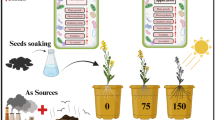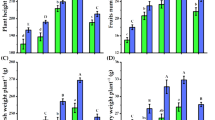Abstract
The present study was focused to recognize the changes in the Safflower (Carthamus tinctorius L. variety PBNS-12), when exposed to different concentration of copper (25, 50 and 100 μM) along with control (0.5 μM) for 10 and 20 days. This experiment used Hoagland’s nutrient solution to meet the external nutrient conditions, which includes micro and macronutrients equivalent to soil solution with copper sulphate (CuSO4. 5H2O) as a metal stress. The plant samples were harvested after 10 and 20 days. The effect of increased concentrations of copper was indicated by the reduction in overall growth with reduced fresh and dry weight. Copper stress caused significant increase in the non- enzymatic antioxidants (polyphenols and flavonoids) in leaves of treated safflower seedlings as compared to the control. Also, enhanced accumulation of proline was observed in the safflower leaves. In response to excess copper concentration, the level of MDA content was found to be increased. The results showed that the copper has time and dose-dependent effects on safflower seedlings.










Similar content being viewed by others
Abbreviations
- ROS:
-
Reactive oxygen species
- MDA:
-
Malondialdehyde
- TI:
-
Tolerance Index
- FW:
-
Fresh weight
References
Adrees M, Ali S, Rizwan M, Ibrahim M, Abbas F, Farid M, Zia-ur-Rehman M, Irshad MK, Bharwana SA (2015) The effect of excess copper on growth and physiology of important food crops: a review. Environ Sci Pollut Res 22:8148–8162
Ahmad P, Jaleel CA, Azooz MM, Nabi G (2009) Generation of ROS and non-enzymatic antioxidants during abiotic stress in plants. Bot Res Int 2(1):11–20
Ahmed A, Hasnain A, Akhtar S, Hussain A, Abaid-ullah YG, Wahid A, Mahmood S (2010) Antioxidant enzymes as bio-markers for copper tolerance in safflower (Carthamus tinctorius L.). Afr J Biotechnol 9(33):5441–5444
Al Chami Z, Amer N, Al Bitar L, Cavoski I (2015) Potential use of Sorghum bicolor and Carthamus tinctorius in phytoremediation of nickel, lead and zinc. Int J Environ Sci Technol 12(12):3957–3970
Alaoui-Sossé B, Genet P, Vinit-Dunand F, Toussaint ML, Epron D, Badot PM (2004) Effect of copper on growth in cucumber plants (Cucumis sativus) and its relationships with carbohydrate accumulation and changes in ion contents. Plant Sci 166:1213–1218
Alia, Saradhi PP (1991) Proline accumulation under heavy metal stress. J Plant Physiol 138:554–558
Arduini I, Godbold DL, Onnis A (1994) Cadmium and copper change root growth and morphology of Pinus pinea and Pinus pineaster seedlings. Physiol Plant 92:675–680
Azooz MM, Abou-Elhamd MF, Al-Fredan MA (2012) Biphasic effect of copper on growth, proline, lipid peroxidation and antioxidant enzyme activities of wheat (Triticum aestivum cv. Hasaawi) at early growing stage. Am J Crop Sci 6(4):688–694
Bates LS, Walderen RD, Taere ID (1973) Rapid determination of free proline for water stress studies. Plant Soil 39:205–207
Boguszewska D, Zagdańska B (2012) ROS as signaling molecules and enzymes of plant response to unfavorable environmental conditions. InTech, Rijeka, Croatia, pp. 341–362
Bouazizi H, Jouili H, Geitmann A, Ferjani EEI (2010) Copper toxicity in expanding leaves of Phaseolus vulgaris L.: antioxidant enzyme response and nutrient element uptake. Ecotoxicol Environ Safe 73:1304–1308
Chang C, Yang M, Wen H, Chern J (2002) Estimation of total flavonoid content in propolis by two complementary colorimetric methods. J Food Drug Anal 10:178–182
Chen CT, Chen LM, Lin CC, Kao CH (2001) Regulation of proline accumulation in detached rice leaves exposed to excess copper. Plant Sci 160:283–290
Dajue L, Mundel HH (1996). Safflower– Carthamus tinctorius L., International Plant Genetic Resources Institute, 92-9043-297-7, 83
Dey S, Mazumder PB, Paul SB (2014) Effect of copper on growth and chlorophyll content in tea plants (Camellia sinensis (l.) o. kuntze). Int J Res Applied Natural Social Sci 2(5):223–230
El-Beltagi HS, Mohamed HI (2013) Reactive oxygen species, lipid peroxidation and antioxidative defense mechanism. Not Bot Horti Agrobo 41(1):44–57
Ganeva G, Zozikova E (2007) Effect of increasing Cu2+ concentrations on growth and content of free phenols in two lines of wheat (Triticum aestivum) with different tolerance. Gen Appl Plant Physiol 33(1–2):75–82
Hamid N, Bukhari N, Jawaid F (2010) Physiological responses of Phaseolus vulgaris to different lead concentrations. Pakistan J Bot 42(1):239–246
Heath RL, Packer L (1968) Photoperoxidation in isolated chloroplasts. Arch Biochem Biophys 125(1):189–198
Kizil S, Cakmak O, Kirici S, Inan M (2008) A comprehensive study on safflower (Carthamus tinctorius L.) in semi-arid conditions. Biotechnol Biotechnol Eq 23(2):947–953
Korkina LG (2007) Phenylpropanoids as naturally occurring antioxidants: from plant defense to human health. Cell Mol Biol 53:15–25
Kuznetsov VV, Shevyakova NI (1997) Stress responses of tobacco cells to high temperature and salinity. Proline accumulation and phosphorilation of polypeptides. Physiol Plant 100:320–326
Lexmond TM, Van der Vorm PDJ (1981) The effect of pH on copper toxicity to hydroponically grown maize. Neth J Agri Sci 29:217–238
Li S, Zhang G, Gao W, Zhao X, Deng C, Lu L (2015) Plant growth, development and change in GSH level in safflower (Carthamus tinctorius L.) exposed to copper and lead. Arch Biol Sci Belgrade 67(2):385–396
Lombardi L, Sebastiani L (2005) Copper toxicity in Prunus cerasifera: growth and antioxidant enzymes responses of in vitro grown plants. Plant Sci 168:797–802
Mallick S, Sinam G, Mishra RK, Sinha S (2010) Interactive effects of Cr and Fe treatments on plants growth, nutrition and oxidative status in Zea mays L. Ecotoxicol Environ Saf 73:987–995
Mediouni C, Benzarti O, Tray B, Ghorbel MH, Jemal F (2006) Cadmium and copper toxicity for tomato seedlings. Agron Sustain Dev 26:227–232
Patsikka E, Kairavuo M, Sersen F, Aro EM, Tyystjarvi E (2002) Excess copper predisposes photosystem II to photoinhibition, in-vivo by out competing iron and causing decrease in leaf chlorophyll. Plant Physiol 129:1359–1367
Sakihama Y, Cohen MF, Grace S, Hideo C, Yamasaki H (2002) Plant phenolic antioxidant and prooxidant activities: phenolics-induced oxidative damage mediated by metals in plants. Toxicology 17:67–80
Sgherri C, Stevanovic B, Navari-Izzo F (2004) Role of phenolic acid during dehydration and rehydration of Ramonda serbica. Physiol Plant 122:478–485
Singleton VL, Rossi JA (1965) Jr. Colorimetry of total phenolics with phosphomolybdic-phosphotungstic acid reagents. Am J Enol Viticult 16:144–158
Sonmez S, Kaplan M, Sonmez NK, Kaya H, Ilker UZ (2006) High level of copper application to soil and leaves reduce the growth and yield of tomato plants. Sci Agric (Piracicaba, Braz.) 63(3):213–218
Solanki R, Anju P, Dhankhar R (2011) Zinc and copper induced changes in physiological characteristics of Vigna mungo (L.). J Environ Biol 32:747–751
Tanyolac D, Ekmekci Y, Unalan S (2007) Changes in photochemical and antioxidant enzyme activities in maize (Zea mays L.) leaves exposed to excess copper. Chemosphere 67:89–98
Vinod K, Awasthi G, Chauchan PK (2012) Cu and Zn tolerance and responses of the biochemical and physiochemical system of wheat. J Stress Physiol Biochem 8(3):203–213
Wani PA, Khan MS, Zaidi A (2007) Cadmium, chromium and copper in greengram plants. Agron Sustain Dev 27:145–153
Xiong ZT, Wang H (2005) Copper toxicity and bioaccumulation in Chinese cabbage (Brassica pekinensis rupr.). Environ Toxicol 20:188–194
Xiong Z, Liu C, Geng B (2006) Phytotoxic effects of copper on nitrogen metabolism and plant growth in Brassica pekinensis rupr. Ecotoxicol Environ Saf 64:273–280
Yar HS, Ismail DK, Alhmed MN (2012) Hepatoprotective effect of Carthamus tinctorius L. against carbon tetrachloride induced hepatotoxicity in rats. Pharmacie Globale 9(2):1–5
Yurekli F, Porgali ZB (2006) The effects of excessive exposure to copper in bean plants. Acta Biol Cracov Ser Bot 48(2):7–13
Zengin FK, Kirbag S (2007) Effects of copper on chlorophyll, proline, protein and abscisic acid level of sunflower (Helianthus annuus L.) seedlings. J Environ Biol 28(3):561–566
Zhao S, Liu Q, Qi Y, Duo L (2010) Responses of root growth and protective enzymes to copper stress in turfgrass. Acta Biol Cracov Ser Bot 52(2):7–11
Acknowledgment
Authors are thankful to Prof. Aditya Shastri, Hon. Vice Chancellor, Banasthali University, Banasthali (Rajasthan), India for providing facilities for experimental work. Also we are thankful to Directorate of Oilseed Research (ICAR), Rajendranagar, Hyderabad (A.P.) India, for providing seeds to conduct this study.
Author information
Authors and Affiliations
Corresponding author
Rights and permissions
About this article
Cite this article
Gautam, S., Anjani, K. & Srivastava, N. In vitro evaluation of excess copper affecting seedlings and their biochemical characteristics in Carthamus tinctorius L. (variety PBNS-12). Physiol Mol Biol Plants 22, 121–129 (2016). https://doi.org/10.1007/s12298-016-0339-1
Received:
Revised:
Accepted:
Published:
Issue Date:
DOI: https://doi.org/10.1007/s12298-016-0339-1




